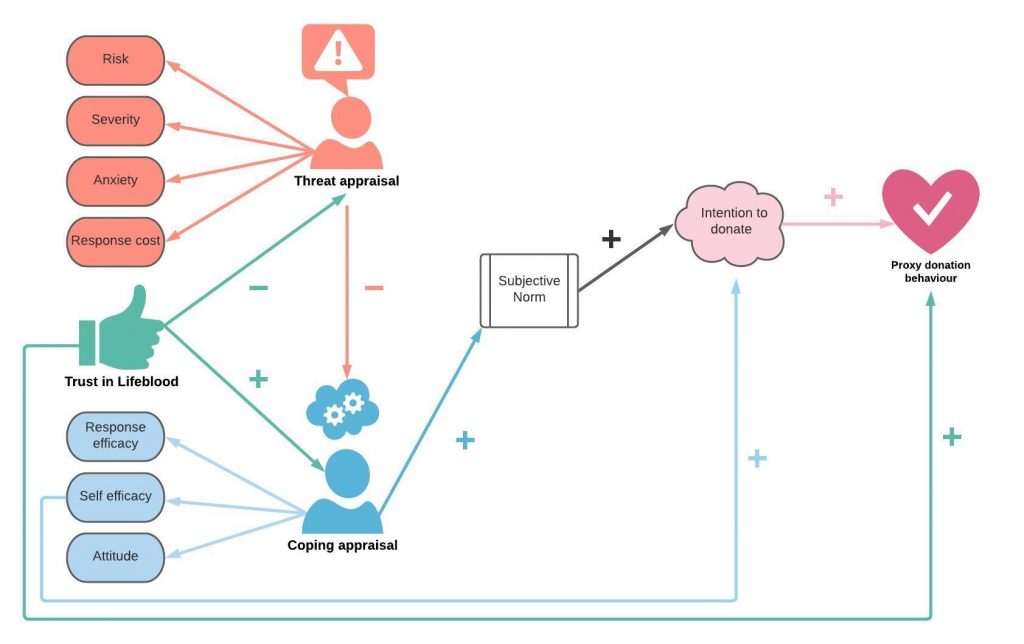
COVID-19 (unfortunately) is staying with us, and its presence has impacted the blood supply, with some blood collection agencies putting out urgent calls for donors. But what influences the decision to donate during a pandemic? Research from China during the early stages of the COVID-19 pandemic identified fear of infection as a key reason behind people not wanting to donate blood. However, how does this fear fit with all the other reasons that prevent or encourage people to donate?
To explore this question, Barbara Masser, Melissa Hyde, and Eamonn Ferguson surveyed Australian blood donors and non-donors between May and June of this year. They looked at what contributes to people’s plans (intentions) to donate blood during this pandemic and whether they took steps to find out how to donate (proxy donation behaviour). Survey respondents were first given information about donating blood during COVID-19 from Australian government and Australian Red Cross Lifeblood (Lifeblood) websites. Following this, they answered a series of questions about their trust in Lifeblood, along with constructs from Protection Motivation Theory (e.g., threat appraisals) and the Theory of Planned Behaviour (e.g., attitude). Finally, respondents were given the option to click a link to find out how to make an appointment to donate blood.
As with studies of hypothetical pandemic scenarios, the results showed that donors’ and non-donors’ coping appraisals and threat appraisals played a key role in their intentions to donate blood, with trust in Lifeblood also important.
In this study, coping appraisals were derived from participants’ beliefs that donating would be an effective response (to ensure an adequate blood supply etc), their confidence in their ability to donate (i.e., self-efficacy), and how positively they felt (i.e., attitude) about donating, during the pandemic. Threat appraisals were informed by participant’s’ assessment of the risk of donating during a pandemic, the likelihood they would be infected if they were to donate, their anxiety about donating, and the (potential) cost of donating in terms of risk of contracting or spreading this coronavirus.
Coping and threat appraisals influenced participant’s views on whether others would want them to donate (subjective norm), and this approval along with self-efficacy, directly linked to intentions to donate blood during the pandemic.
How does trust fit in? Interestingly, trust in Lifeblood contributed to both higher coping appraisals and lower threat appraisals about donating. Trust in Lifeblood, along with intention, was also a significant positive predictor of finding out how to make an appointment to donate.

How can we use these results to encourage people to donate during the COVID-19 pandemic? Overall, the data suggests that blood collection agencies should make building and preserving the trust of their (potential) donors their number one priority. Blood collection agencies can achieve this through honest and sincere communications that convey the organisation’s genuine interest in the ongoing wellbeing of their donors. Reassure donors that the threat of contracting COVID-19 from donating is minimal, and give (potential) donors virtual ‘walk throughs’ of donor centres during COVID-19 to clearly show the operational changes made to protect donors. Examples of such changes which have already been implemented at Lifeblood, could be onsite temperature taking, mask wearing protocols, cleaning processes, and social distancing in centres.
Providing clear information about these changes will allow donors to build a new ‘donating during COVID-19’ script and have every confidence that, despite the pandemic, they can start, continue, or return to being a ‘bloody life saver’.
Michael Lam, Barbara Masser, & Melissa Hyde



![]()
